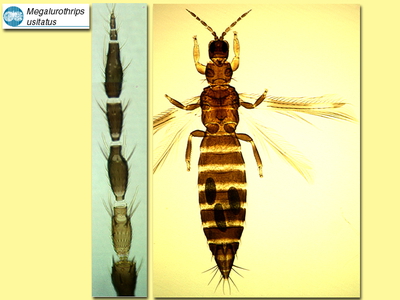Figures
Fig. 1 Antenna, head, thorax and abdomen
Fig. 2 Head (dorsal)
Fig. 3 Fore and hind wing
Fig. 4 Pronotum
Fig. 5 Metanotum and sternite VII
Fig. 6 Tergite VIII
Species
Megalurothrips usitatus Bagnall
Biology
Breeding in a range of legume flowers, this species is recorded as a minor pest of soybean, mungbean and groundnut in Java.
Distribution
Widespread in the tropics from Pakistan to Australia and the Pacific Islands.
Recognition
Body dark brown, tarsi, fore tibiae and apices of mid and hind tibiae yellow; antennal segment III light brown; forewings brown with pale band sub-basally and sub-apically; major setae dark. Head slightly longer than wide, with 3 pairs of ocellar setae; pair III long and arising just outside ocellar triangle. Antennae 8-segmented, III & IV with sense cone forked. Pronotum with 2 pairs of long posteroangular setae, also one pair of posteromedian and one pair of anteroangular setae larger than discal setae. Metanotum with median setae long and arising at anterior margin. Forewing with complete row of setae on second vein, but setal row on first vein interrupted at sub-apical pale band. Tergites without ctenidia laterally, but VIII with an irregular patch of microtrichia anterolaterally; VIII with posteromarginal comb of fine microtrichia developed laterally but not medially; X with dorsal split very short. Sternites with no discal setae, VII with median pair of marginal setae arising in front of margin. Male similar to female in structure, but smaller and paler; tergite IX with 1 pair of lateral setae short and stout; sternites without glandular areas.
Related species
There are seven species listed in this genus, all in the flowers of legumes in the Old World tropics, but the females of five Asian species cannot be distinguished satisfactorily from M. usitatus (Palmer, 1987).







